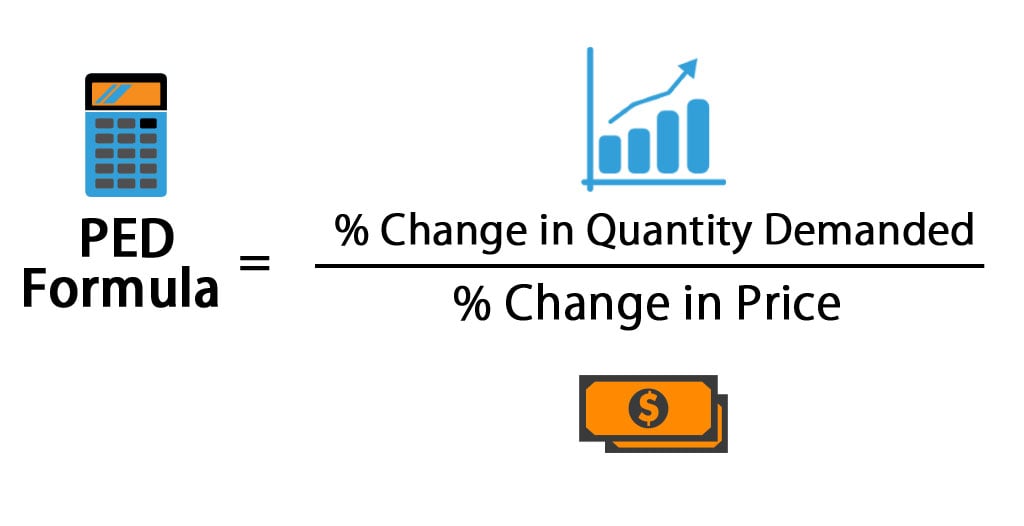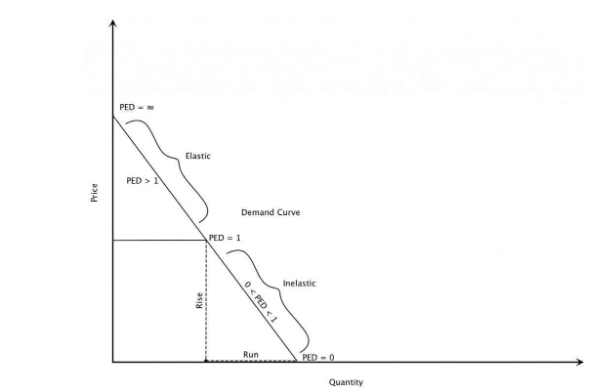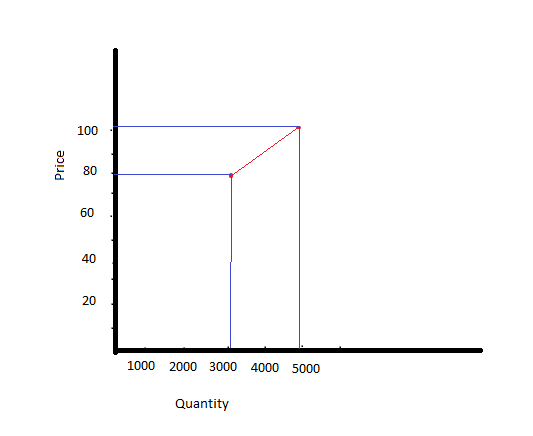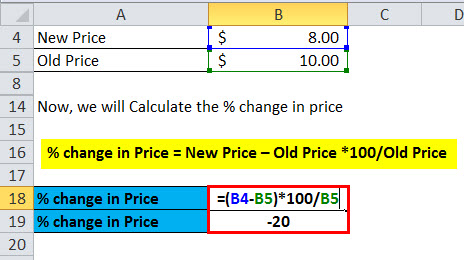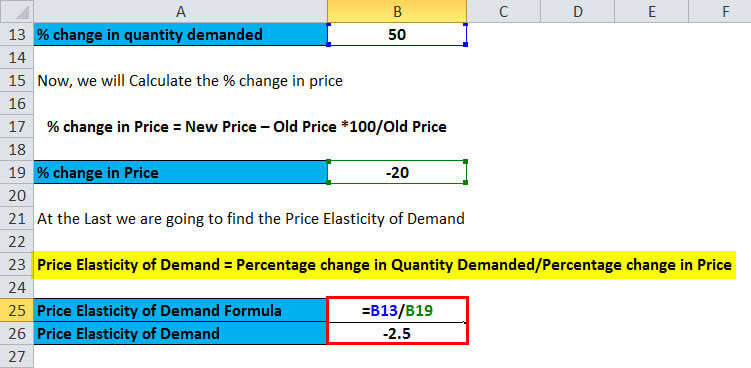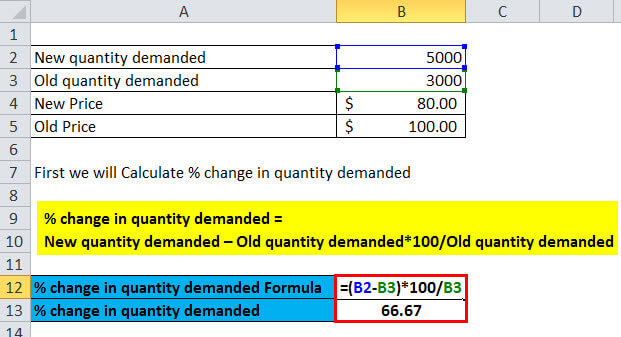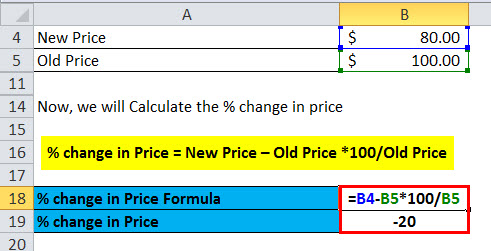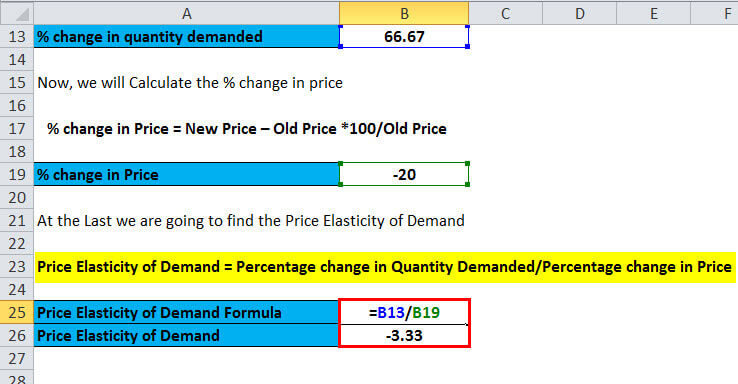Updated November 24, 2023
Price Elasticity Of Demand Formula (Table of Contents)
- Price Elasticity Of Demand Formula
- Price Elasticity Of Demand Formula Calculator
- Price Elasticity Of Demand Formula in Excel(With Excel Template)
Price Elasticity Of Demand Formula
Price elasticity of demand is an economic measurement of how demand and supply change effect the price of a product and vice versa. So, price elasticity is the percentage change in Quantity to the percentage change in price.
The Formula for calculating the Price Elasticity Of Demand is as follows:
Where,
It means when demand or supply for any product changes, it will impact the price of a product in an economy. In the case of elastic goods with a change in price, the demand and supply of products get affected, whereas if a product is inelastic with a change in price, demand and supply do not change.
Examples of Price Elasticity Of Demand Formula
Let’s see an example to understand the price elasticity of the demand formula.
Example #1
Suppose a fancy soap was in demand in a town percentage of change in Quantity demanded is 20%, and the percentage change in price is 10%; the price elasticity of demand will be:-
Hence,
- Price Elasticity of Demand = Percentage change in Quantity Demanded/Percentage change in Price
- Price Elasticity of Demand = 20%/10%
- Price Elasticity of Demand =2%
So, price elasticity demand is 2%.
The price elasticity of demand is the slope of a demand curve. This curve tells us the impact on the price of change in demand and supply. The value of Price elasticity of demand is negative as price and demand are inversely proportional to each other and in the opposite direction; if the price increases, demand decreases, and if the price decreases, demand increases.
Now, let us take another example to study the same.
Example #2
Plastic manufacturing companies that manufacture plastic boxes decide to decrease their price from $10 to $8 and predict an increase in monthly sales from 2,000 to 3,000 a month. To find price elasticity demand.
First,
We will calculate the percentage change in quantity demand.
- % change in quantity demanded = New quantity demanded – Old quantity demanded *100/Old quantity demanded
- % change in quantity demanded = 3000 – 2000 *100/2000
- % change in quantity demanded = 50%
Then we will find out the change in price by using the change in price formula
- % change in Price = New Price – Old Price *100/Old Price
- % change in Price = 8-10*100/10
- % change in Price = -20%
Now, we will find the Price Elasticity of Demand using the Formula below.
- Price Elasticity of Demand = Percentage change in Quantity Demanded/Percentage change in Price
- Price Elasticity of Demand = 50%/-20%
- Price Elasticity of Demand = -2.5%
So, the price elasticity of demand is -2.5.
This means that demand is elastic.
Now, let us see the demand curve.
The Demand Curve is the curve formed due to the change in price and demand. Below is a sample of a demand curve.
Price elasticity of demand on the demand curve
In the demand graph,
There is a different type of price elasticity of demand they are as follows:-
1. Perfect Inelastic Demand
In perfect inelastic demand, there is no change in demand with a price change; the value of price elasticity will be zero, and the demand value will be constant.
Here, the demand curve is straight.
PED = 0
2. Relatively Elastic Demand
If the value of price elasticity demand exceeds one, then a product is elastic. Here, the demand curve is gradually sloping.
1 < PED < ∞
3. Relatively Inelastic Demand
If the value of price elasticity demand is less than one, a product is inelastic. Here, the demand curve is rapidly sloping.
0 < PED < 1
4. Unit Elastic Demand
When the proportional change in demand produces the same change in the price, then it is unit elastic demand.
PED = 0
5. Perfectly Elastic Demand
It means that a slight price increase will lead to a decrease in demand, and even demand can decrease to zero; if a slight price decrease will lead to an increase in demand, and even demand can increase to infinity. The demand curve for perfectly elastic demand is a horizontal straight line.
PED = ∞
Law of Demand and Supply
- Law of Demand: Under all conditions, the equal demand law states that with an increase in the price of a product, demand for the product decreases, and with a decrease in the price of a product, demand increases. Hence, the law of demand tells us that price and demand are inversely related.
- Law of Supply: Under all states, constant supply laws state that with an increase in the price of a product, supply for the product increases, and with a decrease in the price of a product, supply for the product decreases. Hence, the law of supply tells us that price and demand are directly related.
Now, we will see factors that affect price elasticity.
Factors that Affect Price Elasticity
- Number of Alternatives: There are multiple brands available in the market; if the price of one product increases, the consumer can shift to other alternative brands and products.
- Price of Product in Relation to Income: When a family’s income increases or decreases with it, their demand for goods or services also changes. Here, demand and supply are elastic.
- Cost of Alternative: When one change goods or service from one brand to another, there is a cost involved which could be in terms of fees, or extra charges may be with it, they are providing other benefits… Hence the demand is inelastic.
- Brand Specific: Generally, people are brand specific, and with an increase or decrease in the price, demand does not change, which means demand is inelastic.
- Necessary for Goods: Some goods that consumers must buy irrespective of price, like medicines, mean demand is inelastic.
Let us see one more example.
Example #3
Here, a two-year-old start-up manufacturing company wants to study the market and fix the price of its goods as per consumers’ demand in the current economic situation. Two years back, the company had 3000 consumers with the price of goods at $100, and now they predicted to increase sales by 5000 after a decrease in price to $85.
- % change in quantity demanded = New quantity demanded – Old quantity demanded *100/Old quantity demanded
- % change in quantity demanded = 5000 – 3000 *100/3000
- % change in quantity demanded = 200000/3000
- % change in quantity demanded = 66.66%
Then we will find out the change in price by using the change in price formula
- % change in Price = New Price – Old Price *100/Old Price
- % change in Price = 80 – 100*100/100
- % change in Price = -20%
Now, we will find the Price Elasticity of Demand using the Formula below.
- Price Elasticity of Demand = Percentage change in Quantity Demanded/Percentage change in Price
- Price Elasticity of Demand = 66.66/-20
- Price Elasticity of Demand = -3.33
So, the price elasticity of demand is -3.33, which means the product is elastic.
Now see a graph for the same.
Graph for Price Elasticity of Demand
Significance and Use
There are many uses of price elasticity of demand. They are as follows:-
- It helps a company to analyze the impact of price change.
- It helps the government while making taxation policies.
- A company makes various decisions based on the price elasticity of demand study, like a tax to be paid by the customer or self.
- Help to implement the price discrimination concept where a product has a different price in a different market.
There is one disadvantage to the company in the case of elastic demand when it does not know what price to fix for selling. If the price is high, consumers will not buy, and if the price is low company will face loss. The price elasticity of demand affects consumers as well as industries. Demand elasticity helps the company fix its price and calculate and predict sales and revenue.
Price Elasticity Of Demand Formula Calculator
You can use the following Price Elasticity Of Demand Calculator
| Percentage Change in Quantity Demanded | |
| Percentage Change in Price | |
| Price Elasticity of Demand | |
| Price Elasticity of Demand = |
|
|
Price Elasticity Of Demand Formula in Excel (With Excel Template)
Here, we will do the same example of the Price Elasticity Of Demand formula in Excel. It is very easy and simple. You need to provide the two inputs, i.e., % change in Quantity Demanded and % change in price
You can easily calculate the Price Elasticity of Demand using the Formula in the template provided.
In this template, we have to solve the Price Elasticity Of Demand Formula
Price Elasticity of Demand for fancy soap is calculated as:
Price Elasticity of Demand for plastic manufacturing companies is calculated as:
First, we will calculate the % change in Quantity demanded
Now, we will Calculate the % change in price
At last, we are going to find the Price Elasticity of Demand Formula
The price Elasticity of Demand for a manufacturing company is calculated as follows:
First, we will calculate the % change in Quantity demanded
Now, we will Calculate the % change in price
At last, we are going to find the Price Elasticity of Demand
You can download this Price Elasticity Of Demand Formula Excel Template here – Price Elasticity Of Demand Formula Excel Template.
Conclusion – Price Elasticity Of Demand Formula
There is one disadvantage to a company in the case of elastic demand when it does not know what price to fix for selling. If the price is high, consumers will not buy, and if the price is low company will face loss. The price elasticity of demand affects consumers as well as industries. Demand elasticity helps a company fix its price and calculate and predict sales and revenue.
Recommended Articles
This has guided the Price Elasticity Of Demand Formula; here, we discuss its uses and practical examples. We also provide a Price Elasticity Of Demand calculator and a downloadable Excel template.

